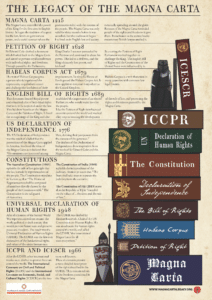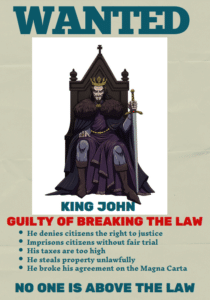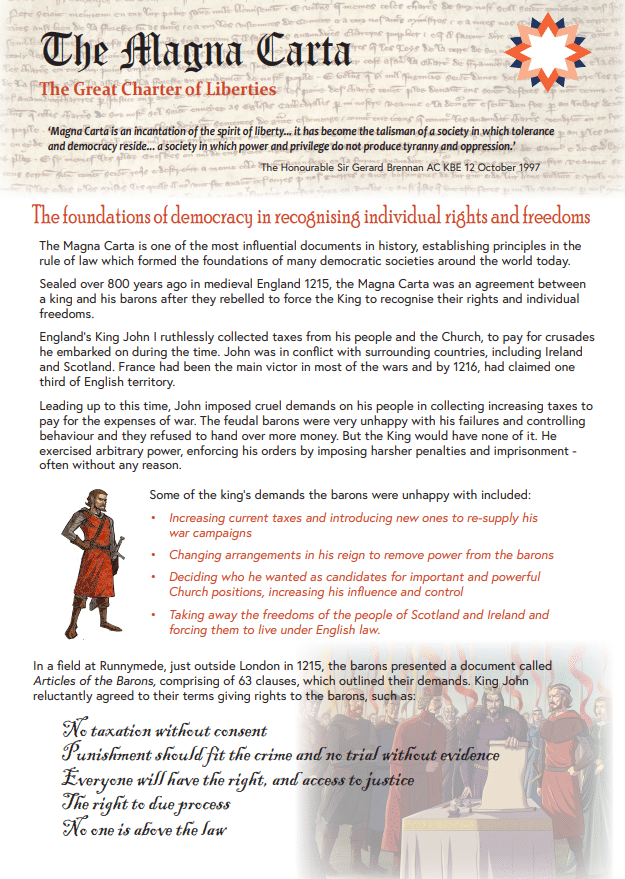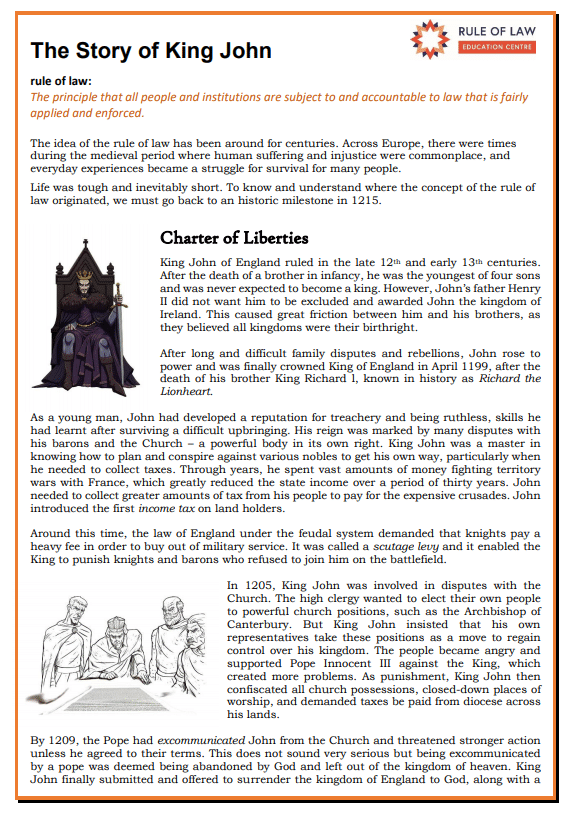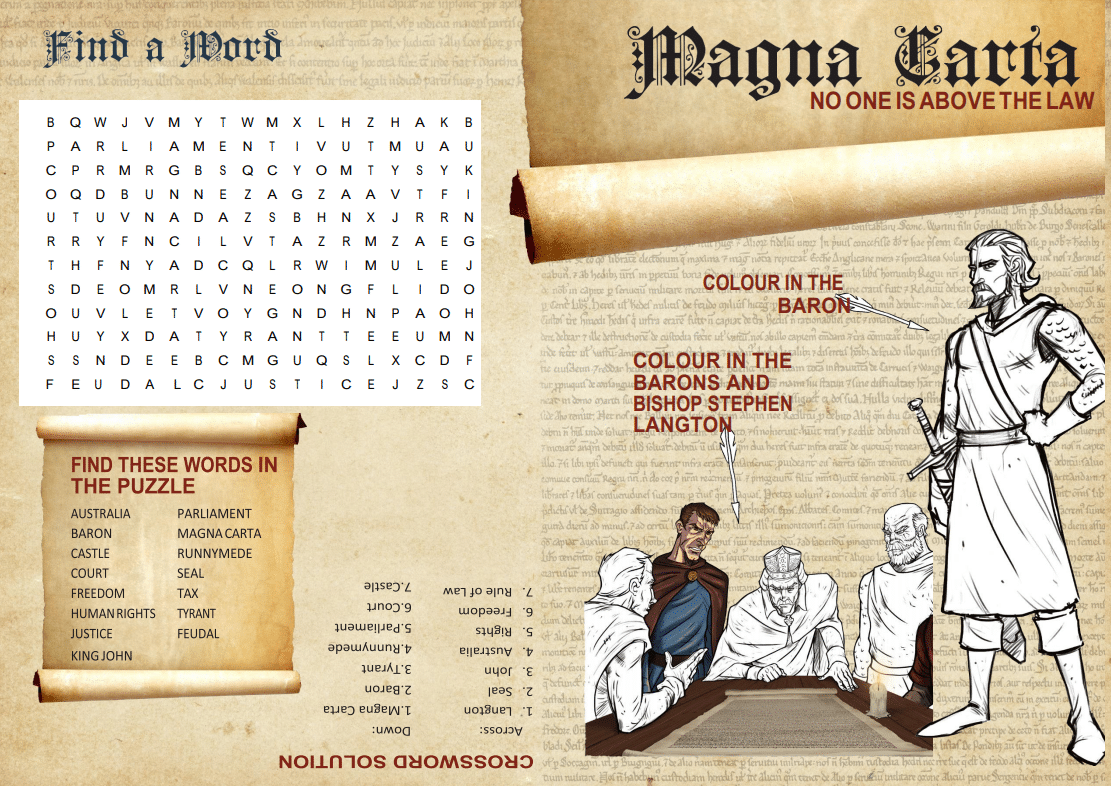Magna Carta and Human Rights
What is the relationship between the Magna Carta and Human Rights?
The Magna Carta, which is Latin for The Great Charter, was a list of demands and expectations forced on the evil King, John of England in 1215. King John was so evil, he heavily taxed his people, arbitrarily took their possessions and threw them into prison for the slightest reason.
By sealing the Magna Carta, King John was agreeing to follow the laws of the land. It gave the people a mechanism to limit the power of the King and assert their rights.
The Magna Carta established the rule of law and the idea that all citizens, including those in power, should be fairly and equally ruled by the law. It began the tradition of respecting the law, limiting government power, providing access to justice and the protection of human rights.
The most famous clauses of the Magna Carta are clauses 39 and 40:
Clause 39: No free man shall be seized or imprisoned, or stripped of his rights or possessions, or outlawed or exiled, or deprived of his standing in any way, nor will we proceed with force against him, or send others to do so, except by the lawful judgment of his equals or by the law of the land.
Clause 40: To no one will we sell, to no one will we refuse or delay, right or justice
Reissues of Magna Carta reinforced the rights and freedoms it gave the people and the right to limit the power of the government.
The legacy of the Magna Carta is seen not only in English law, but throughout the world. The true power of the Magna Carta lies in its impact on later documents, and the creation of a culture of the rule of law and a respect for individual’s rights by those in power.
This resource explores the legacy of the Magna Carta and its effect on human rights documents, tracing the evolution from the Magna Carta to the Universal Declaration of Human Rights, and giving an overview of the relationship between the Magna Carta and Human Rights.
Tracing the Legacy of the Magna Carta through Human Rights Documents
England: Petition of Right 1628
To fund his war in Spain, King Charles I forced his people to loan him money- and those who refused were thrown in jail. Sir Edward Coke and the English parliament were not happy!
To get King Charles I to re-commit to observe the rule of law, they drafted the Petition of Right, reminding King Charles I of their rights under the Magna Carta. The Petition was considered a ‘true exposition of the Great Charter’ as it confirmed the people’s rights such as:
- no taxation without consent of Parliament
- no imprisonment without a cause
It became an Act of Parliament in 1628 and is regarded as a Constitutional document of the UK.
England: Habeas Corpus Act 1679
Fearing that King Charles II’s successor might disregard their liberties, the English parliament passed the Habeas Corpus Act in 1679.
Whilst the Magna Carta stated that no one could be imprisoned unlawfully, by 1679, the writ Habeas Corpus gave a person who is imprisoned the opportunity to go before a court and challenge the legality of their imprisonment. Habeas Corpus means ‘bring out the body’ ie an order compelling the jailer/king/State to bring the prisoner to court to explain why they are held captive and if no legal reason is found, they must be released.
The Act remains in effect and has been included as a fundamental right in many common law countries.
Click on the different books below to see the clauses that have been shaped by the Magna Carta.
England: Bill of Rights 1689
After authoritarian King James II fled to France in 1688, Parliament required the next King, future King William III (and wife Mary), assent to the Bill of Rights before they could take the Crown.
The Bill of Rights was presented to the parliament as ‘the second Magna Charta’ to preserve the ancient rights and liberties of the nation. It listed the wrong doings of King James II and echoed the Magna Carta with its insistence on due process, no taxation without agreement, and freedom from government interference. It also established the principle of frequent parliaments, free elections, and free speech within parliament. The main principles are still in force today and is considered a Constitutional document of England. The Bill of Rights became a model for the US Bill of Rights and UN Declaration of Human Rights.
United States of America: Declaration of Independence 1776, Constitution and Bill of Rights
The drafters of the US Declaration of Independence, Constitution and Bill of Rights wanted to recognise the same rights as they had in England and strived for protection from oppressive rule through checks on government power. They drew inspiration from the English legacy of Sir Edward Coke’s Petition of Right and the Magna Carta. It declared Governments are instituted among Men, deriving their just powers from the consent of the governed. The 5th Amendment to the Constitution (part of the Bill of Rights) is derived from Magna Carta ‘no person shall… be deprived of life, liberty, or property, without due process of law.’
Australian Constitution 1901
The legacy of the Magna Carta, instilled in English law, came as part of the ‘invisible cargo’ with the First Fleet on settlement in Sydney Cove in 1788. The Magna Carta formed the basis of the vision that all Australians would be treated consistently and fairly under the law. See further details in our article: Magna Carta: A Vision of Justice and Freedom.
With the First Charter of Justice came the start of the rule of law and Courts that provided, in a limited way, the birthrights and liberties that were inspired by the Magna Carta.
The Australian Constitution came into effect in 1901 and was based upon the rule of law, with the separation of powers to provide a check on government power and protect the rights of the people.
As stated by Hon Susan Crennan AC QC, former Justice of the High Court of Australia in her speech ‘Magna Carta, Common Law Values and the Constitution’:
“The Australian Constitution, a law of the Imperial Parliament, was not drafted in the context of any rupture, war or revolt against the supremacy of Westminster. It contains no Bill of Rights which prevents the legislature from passing laws that infringe such rights. It is readily distinguishable from the American Constitution, not least because it contains nothing equivalent to the guarantees of due process to be found in the Fifth and Fourteenth Amendments. The distinct features of the Australian Constitution blend three aspects of political and constitutional theory: responsible government derived from the British constitutional tradition; the separation of powers derived from the American Constitution; and our own local, colonial understandings of democratic theory and principles. It was obvious from the start that, although the Constitution contains no specific provisions for judicial review ensuring the constitutional validity of laws, the framers plainly intended that the High Court should, as Alfred Deakin put it, decide “the orbit and boundary of every power.”
Universal Declaration of Human Rights 1948
The UNDHR is a treaty that preserves peoples’ peace and freedom and is considered the Magna Carta of our age. It was the first declaration that recognised the fundamental rights and values of all people, everywhere. Drafted by Eleanor Roosevelt, Chair of the UN Commission on Human Rights, the UNDHR recognises its origins: ‘The international Magna Carta is for all men everywhere.’
ICCPR and ICESCR 1966
The International Covenant on Civil and Political Rights (ICCPR) and the International Covenant on Economic, Social, and Cultural Rights (ICESCR) provide a detailed description of the rights presented in the UDHR, for modern times. The legacy of the Magna Carta can be seen in many of the clauses.
For example Article 9 of the ICCPR aligns with clause 40 of the Magna Carta and due process:
Anyone arrested or detained on a criminal charge shall be brought promptly before a judge or other officer authorised by law to exercise judical power and shall be entitled to trial within a reasonable time or to release.
Article 2 of the ICESCR relates to the Magna Carta and the rule of law generally:
The States Parties to the present Covenant undertake to guarantee that the rights enunciated in the present Covenant will be exercised without discrimination of any kind as to race, colour, sex, language, religion, political or other opinion, national or social origin, property, birth or other status.
Magna Carta Posters
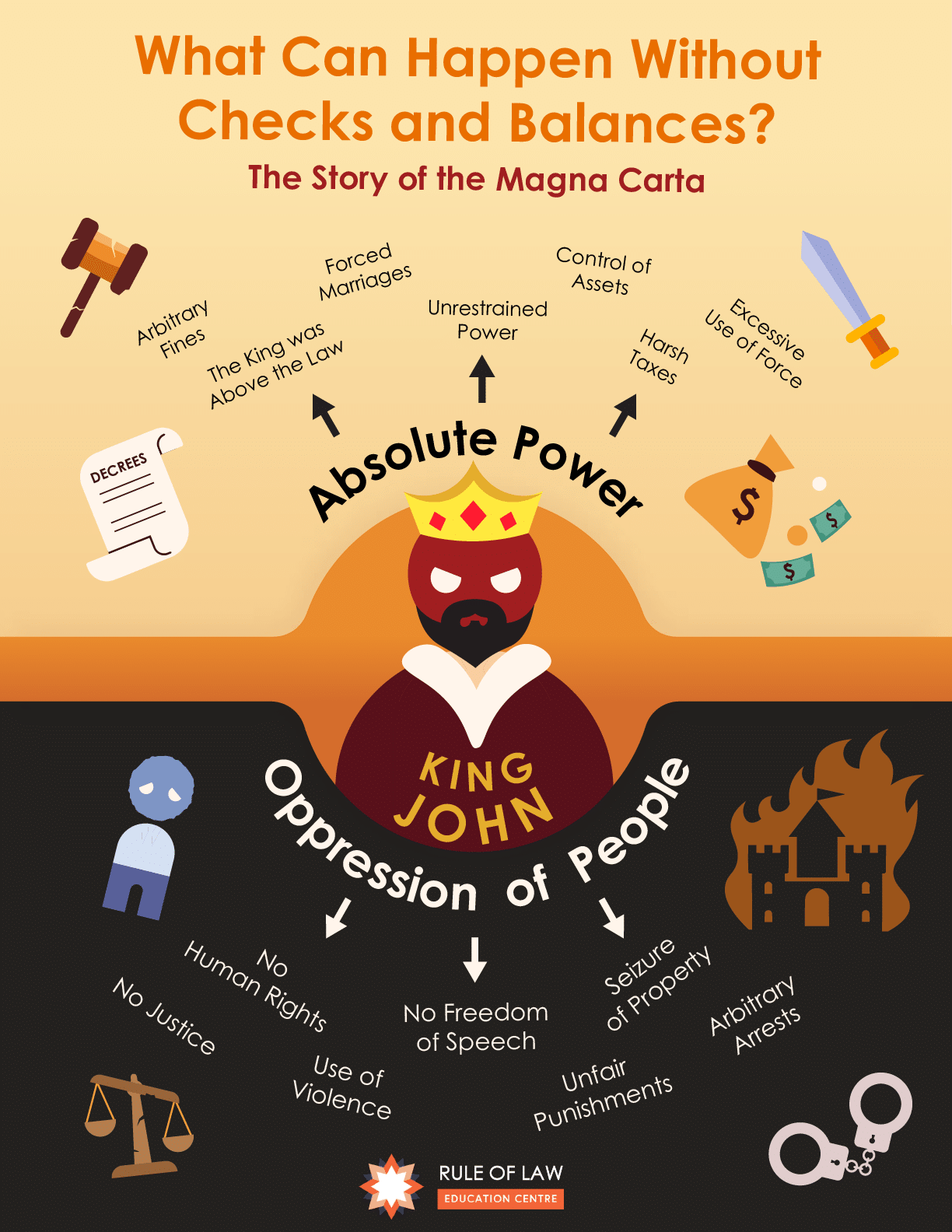
Video: The Magna Carta: Principles of the Rule of Law in Australia today
Activities to go with the video:
- Quick Quiz and short answer questions
- Fill in the Blanks Activity
The Magna Carta Poster is accompanied by three videos from the Rule of Law Series by The Hon Kevin Lindgren AM QC that can be used in the classroom.
In the first video, part 1 of the Rule of Law Series, The Hon Kevin Lindgren AM QC discusses the definition of the rule of law and its relationship with human rights.
Video 1 – Defining the Rule of Law (3:51)
In the second video, part 3 of the Rule of Law Series, The Hon Kevin Lindgren AM QC speaks about important clauses from the Magna Carta and their relevance to the rule of law.
Video 2 – The Rule of Law and Magna Carta (4:13)
In the third video, part 4 of the Rule of Law Series, The Hon Kevin Lindgren AM QC, defines the writ of habeas corpus, and provides a discussion of its significance in English law and other common law jurisdictions.
Video 3 – Habeas Corpus and the Petition of Right (6:56)
Magna Carta Classroom Activities
In this section, teachers will find resources explaining how the story of an 800-year-old document influences the way modern Australia is governed today.
Students can learn about the medieval story of King John and how he was forced by his barons to seal an agreement outlining basic expectations regarding liberty and justice for the people of his kingdom. This historical treaty was called The Great Charter, now known as Magna Carta.
This manuscript aimed to protect human rights so long ago and became the genesis of a concept known as the rule of law. By sealing Magna Carta, King John agreed that he himself will also be subject to the law and administer justice fairly. Its legacy underpins important values embedded in government and legal institutions that serve Australian society today, such as the people’s legislatures, the executive government, and judiciary.

